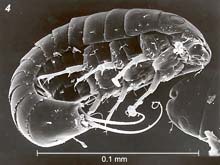
Many types of cancer–like those of the breast and prostate–would not be nearly as deadly if it weren’t for their ability to spread to vital organs. Still, scientists don’t yet fully understand the way in which cancer spreads, or metastasizes, or how to prevent the process.
Now, researchers at the San Francisco VA Medical Center (SFVAMC) have used a modified version of a naturally occurring human protein to decrease the spread of human breast cancer implanted in mice.
“We

By analyzing data on tree pollen extracted from ancient lake sediments, ecologists have sharpened the understanding of how forests can maintain a diversity of species. Their findings indicate that stabilizing processes have been more important than previously thought, and that the human-caused loss of species could upset that stability in ways that remain poorly understood.
“Quantifying the link between stability and diversity, and identifying the factors that promote species diversity, ha

Exhaust from the main engines of NASA’s space shuttle, which is about 97 percent water vapor, can travel to the Arctic in the Earth’s thermosphere where it forms ice to create some of the Earth’s highest clouds that literally shine at night, according to a new study led by the Naval Research Laboratory and jointly funded by NASA and the Office of Naval Research.
The thermosphere is the highest layer in our atmosphere, occupying the region above about 55 miles (88 kilometers) altitude. The c

A completely new way of killing the malaria parasite has been found by researchers at St George’s Hospital Medical School in London. Professor Sanjeev Krishna’s research group is world-renowned in the battle against infectious diseases and has now discovered how to stop the malaria parasite’s sugar transport protein from working. This prevents the parasite growing and multiplying in the red blood cells where it lives. The research is published this week in the Proceedings of the National Academy of S

Oxford scientists have discovered a particularly macabre method one parasite (Strepsiptera) has for disguising itself in its insect host: it wraps itself in a piece of the host’s own body tissue. In this way the strepsipteran masquerades as ‘self’, and is protected from the insect’s immune system.
The mechanism whereby Strepsiptera flourish without interference from the host has so far been a mystery. Scientists have been intrigued by the exceptional diversity of host insects exploited by th

Penn State researchers have developed new software that can help decision-making teams in combat situations or homeland security handle information overload by inferring teams’ information needs and delivering relevant data from computer-generated reports.
The agent software called CAST (Collaborative Agents for Simulating Teamwork) highlights relevant data. This helps improve a team’s decision-making process as well as enhances members’ collaboration.
“This version of C

– new calculation confirms standard model of particle physics. Contribution of hadronic vacuum polarization determined with unprecedented accuracy. The magnetic moment of the muon is an important precision parameter for…
Technique may prevent formation of unwanted waves that siphon off needed energy. Heating plasma to the ultra-high temperatures needed for fusion reactions requires more than turning the dial on a…

An international team of astronomers, led by researchers from the Astronomical Observatory of the University of Warsaw, have identified a new class of cosmic X-ray sources. The findings have been…

How deubiquitinases USP53 and USP54 cleave long polyubiquitin chains and how the former is linked to liver disease in children. Deubiquitinases (DUBs) are enzymes used by cells to trim protein…

Conceptual blueprint to analyze experimental catalyst data. Machine learning (ML) models have recently become popular in the field of heterogeneous catalyst design. The inherent complexity of the interactions between catalyst…

Antibody that Neutralizes Inhibitory Factors Involved in Nerve Regeneration Leads to Enhanced Motor Function after Acute Spinal Cord Injury. Researchers at 13 clinics in Germany, Switzerland, the Czech Republic and…

How simulations help manufacturing of modern displays. Modern materials must be recyclable and sustainable. Consumer electronics is no exception, with organic light-emitting diodes (OLEDs) taking over modern televisions and portable…

“Neurons that fire together, wire together” describes the neural plasticity seen in human brains, but neurons grown in a dish don’t seem to follow these rules. Neurons that are cultured…

The quest for sustainable energy solutions has been a major focus of scientific research for decades. Solar energy, a clean and renewable source, has emerged as a promising alternative to…

With a processing speed a billion times faster than nature, chip-based laser neuron could help advance AI tasks such as pattern recognition and sequence prediction. Researchers have developed a laser-based…

New technology could remotely identify various types of plastics, offering a valuable tool for future monitoring and analysis of oceanic plastic pollution. Researchers have developed a new hyperspectral Raman imaging…

Artificial Intelligence (AI) has established a strong presence across industries, large and small. The “VoBaKI” research project has empowered small and medium-sized enterprises (SMEs) with an innovative tool to independently…